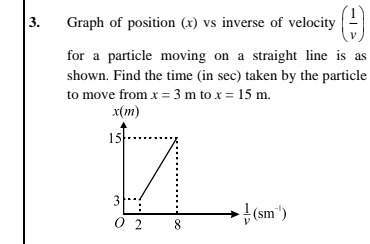Question
Question: Graph of position (x) vs inverse of velocity ($\frac{1}{v}$) for a particle moving on a straight lin...
Graph of position (x) vs inverse of velocity (v1) for a particle moving on a straight line is as shown. Find the time (in sec) taken by the particle to move from x = 3 m to x = 15 m. x(m)
v1(sm−1)

60
Solution
The problem provides a graph of position (x) versus the inverse of velocity (v1) for a particle moving on a straight line. We need to find the time taken by the particle to move from x=3 m to x=15 m.
-
Find the equation of the line: The graph is a straight line passing through two points: (v11,x1)=(2,3) and (v12,x2)=(8,15). Let Y=v1 and X=x. The general equation of a straight line is X=mY+c. Calculate the slope (m): m=v12−v11x2−x1=8−215−3=612=2.
Now, use one of the points (e.g., (2, 3)) to find the y-intercept (c): 3=2(2)+c 3=4+c c=−1.
So, the equation relating x and v1 is: x=2(v1)−1
-
Express v1 in terms of x: From the equation derived above: x+1=v2 v1=2x+1
-
Relate v1 to time and position: We know that velocity v=dtdx. Therefore, v1=dxdt.
-
Set up the integral for time: Substitute the expression for v1 into the differential equation: dxdt=2x+1 dt=2x+1dx
To find the total time (T) taken to move from x=3 m to x=15 m, integrate dt from x=3 to x=15: T=∫3152x+1dx
-
Evaluate the integral: T=21∫315(x+1)dx T=21[2x2+x]315 Now, substitute the limits of integration: T=21[(2152+15)−(232+3)] T=21[(2225+15)−(29+3)] To combine terms, find common denominators: T=21[(2225+230)−(29+26)] T=21[(2255)−(215)] T=21[2255−15] T=21[2240] T=21(120) T=60 seconds
The time taken by the particle to move from x=3 m to x=15 m is 60 seconds.
Explanation of the solution:
- Determine the linear relationship between position (x) and inverse velocity (1/v) from the given graph. The equation is x=2(1/v)−1.
- Rearrange the equation to express 1/v in terms of x: 1/v=(x+1)/2.
- Use the kinematic relation dt=dx/v, which implies dt/dx=1/v.
- Substitute the expression for 1/v into the differential equation: dt=(x+1)/2dx.
- Integrate this expression from the initial position x=3 m to the final position x=15 m to find the total time. The definite integral evaluates to 60 seconds.
